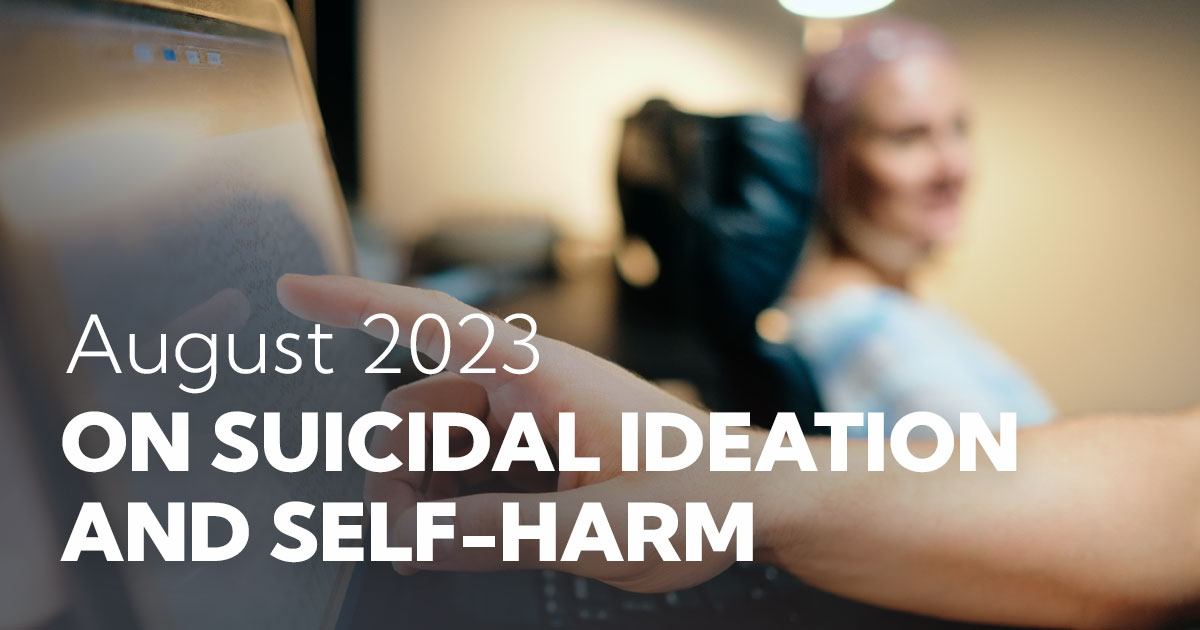On Suicidal Ideation and Self-Harm
by Siegfried Othmer | August 22nd, 2023
We have been successful with quick recovery from suicidal episodes for as long as we have had a chance to work with such cases. This goes back to our early days with EEG band training, the 1990’s, and has continued on a better footing with our excursion into Infra-Low Frequency (ILF) Neurofeedback.* Single-session recoveries came to be expected. Other practitioners in our network reported similar results. Lasting relief from suicidality calls for more sessions. With extended histories of suicidality, recovery is going to involve longer-term training and complementary protocols.
It is difficult to make the case to the healthcare community on the basis of such ‘anecdotal’ reports. After all, recovery from a suicidal episode is the expectation, as there are many more suicidal episodes than there are suicides. Matters are less ambiguous to the therapist, as the recovery likely unfolds in real time within the session. Moreover, facilitating such a recovery is protocol-dependent. So, the clinician is legitimately persuaded that the training process facilitated the recovery. This conviction is strengthened further when suicidality is expunged categorically over the course of additional training sessions.
Given the nature of the issue at hand, it is problematic to arrange for controlled studies. According to the Declaration of Helsinki, once one is persuaded of the efficacy of a therapeutic approach, it is no longer ethical to engage in a placebo-controlled study. This declaration is binding on the individual researcher. For ethical reasons, therefore, one simply must rely on outcome studies.
Our first opportunity to obtain independent validation was in the course of outcome tracking with service members being trained for recovery from combat-related PTSD. Among some 300 cases being tracked over the period of 2009-10, in the early days of ILF neurofeedback, four trainees listed suicidality as an issue. All four responded well over the course of a few weeks at nominally 2-3 sessions per week. The symptom tracking data are shown in Figure 1. Two resolved the issue over the first week, and two others showed substantial resolution over four weeks. It is reasonable to assume, however, that if suicidality had continued to be an issue in those two, they would have come back for more training, which was available to them as service members.

Figure 1. Symptom severity ratings on a ten-point Likert scale are shown for four service members undergoing ILF NF training for recovery from PTSD. Symptom ratings were acquired weekly, with training sessions at 1-3 sessions/week. Data from 2009-10.
More extensive analysis has just become available in a published report on clinical outcome data being obtained in a variety of agencies serving children and adults under the care of the State. This is a very challenging population, as indicated in part by the prevalence of the issue of self-harm and suicidal ideation, as will be seen below. The paper, by Charles Doe and Matthew Fleischman, may be found here: https://www.soa.org/sections/health/health-newsletter/2023/july/hw-2023-07-doe/
Results after twenty sessions of Infra-Low Frequency neurofeedback are shown in the table, which is drawn from the paper, for suicidal ideation and self-harm. With this population, twenty sessions constitutes a good beginning, not the end of the story. Over the course of the first twenty sessions, assurance is gained that an appropriate training protocol has been found. Once the training plateaus with that protocol, or even before, other ILF protocols may be recruited for additional gains. EEG band protocols may be added as well, depending on overall symptom presentation, and finally there may also be a resort to Alpha-Theta training. This protocol is well established for resolving the psychological aspects of the trauma response, to complement the other protocols that target the psychophysiological aspects. Quite clearly, all of this phenomenology must be regarded within the framework of a trauma model.

Table 1. Data summary for recovery from suicidal ideation and self-harm. Symptom reduction over twenty sessions of ILF NF is indicated for the different categories.
For context, it is helpful to show the overall symptom improvement for up to ten top clinical concerns identified for each client. This is shown in Figure 2. The number of clients at each sampling point is indicated. Nice progress is indicated to twenty sessions. The apparent plateau for additional sessions beyond twenty is by virtue of the completion of training by those who have met their goals, which leaves the more severely impaired to dominate progressively with the increasing number of sessions.
Seen in the context of the overall response to the training, progress with suicidal ideation and self-harm was somewhat better than the experience with the typical symptom. So, there was no barrier to progress. Conversely, suicidality shouldn’t be seen in isolation, but rather as an aspect of the global state of dysregulation that eventuates with psychological trauma. The matter must be grasped in its totality, and it must be approached in the same way. That appears to be the particular virtue of ILF Neurofeedback. It serves to resolve issues of core regulation that are disturbed in the trauma response—cerebral stability, affect regulation and arousal regulation—more efficiently than other neurofeedback approaches, which makes it particularly suitable for the training of trauma conditions. That established the foundation for resolving more specific complaints with more targeted protocols.

*A first case of suicidality associated with treatment-resistant Bipolar Disorder was presented at conference in 1995.)
Resources:
Endogenous Neuromodulation at Infra-Low Frequencies (2023)
Siegfried Othmer
https://www.researchgate.net/publication/372159982_Endogenous_Neuromodulation_at_Infra-Low_Frequencies
The Evolution of a Trauma Protocol Over a Quarter Century (2021)
Siegfried Othmer and Susan F. Othmer
https://www.researchgate.net/publication/350470430_The_Evolution_of_a_Trauma_Protocol_Over_a_Quarter_Century
Endogenous Neuromodulation at Infra-Low Frequencies (2013)
Siegfried Othmer, Susan Othmer, David Kaiser, and John Putman
https://www.researchgate.net/publication/259455519_Endogenous_Neuromodulation_at_Infralow_Frequencies
Clinical neurofeedback: Training brain behavior (2011)
Siegfried Othmer and Stella Legarda
https://www.researchgate.net/publication/284506346_Clinical_neurofeedback_Training_brain_behavior
Post-Traumatic Stress Disorder—The Neurofeedback Remedy (2009)
https://www.researchgate.net/publication/239280365_Post_Traumatic_Stress_Disorder-The_Neurofeedback_Remedy





